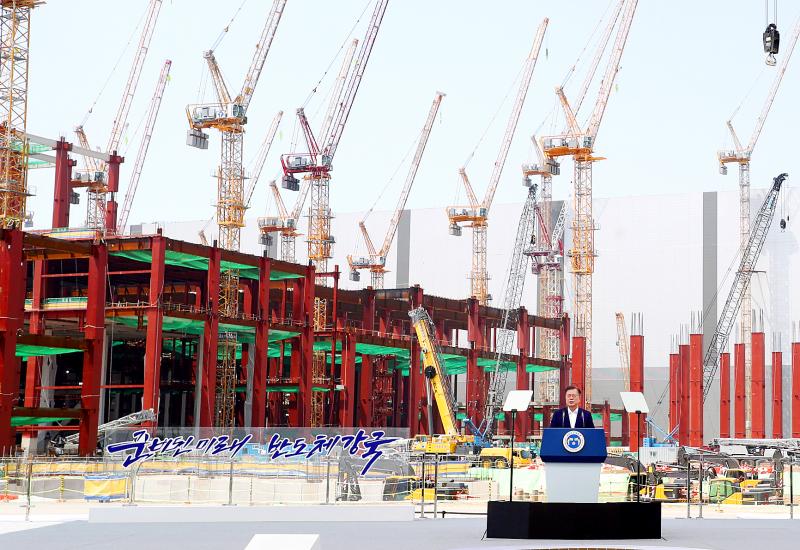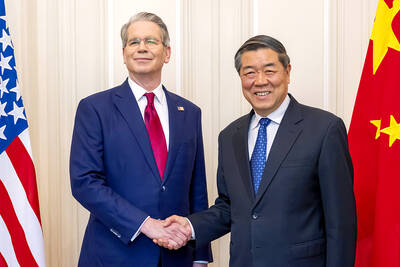South Korea unveiled ambitious plans to spend about 510 trillion won (US$450 billion) to build the world’s biggest chipmaking base over the next decade, joining China and the US in a global race to dominate the key technology.
Samsung Electronics Co and SK Hynix Inc would lead in the investment of 510 trillion won in semiconductor research and production through 2030 under a national blueprint devised by the administration of South Korean President Moon Jae-in.
Samsung and Hynix would be among 153 companies driving the decade-long push, intended to safeguard the nation’s most economically crucial industry.

Photo: EPA-EFE
Yesterday, Moon was briefed by chip executives on the initiative during a visit to the country’s most advanced chip factory, a Samsung plant south of Seoul.
Samsung is boosting its spending by 30 percent to US$151 billion through 2030, while Hynix is committing US$97 billion to expansion at existing facilities, in addition to its US$106 billion plan for four new plants in Yongin, cochief executive officer Park Jung-ho said at the event.
“Major global competitors are pressing ahead with massive investment to be the first to take the future market,” Moon said in a speech. “Our companies have been taking risks and innovating as well, and have completed preparations for tumultuous times.”
The effort comes at a time when the US, China and the EU seek to shore up their semiconductor capabilities after a global chip shortage exposed a reliance on just a handful of Asian manufacturers and hobbled efforts to repair economies scarred by the COVID-19 pandemic.
The shortages are spreading from vehicles to smartphones and displays, elevating semiconductors onto the agendas of governments from Washington to Brussels and Beijing.
At stake is a technology fundamental to groundbreaking advances from artificial intelligence (AI) to autonomous vehicles and connected homes.
South Korea, a security ally of the US and a major exporter to China, has been walking a tightrope between the two, while bolstering its own production prowess.
Semiconductors account for the largest share of South Korea’s exports, and chip exports are expected to double to US$200 billion by 2030, the South Korean Ministry of Trade, Industry and Energy said.
Likening semiconductors to rice — a global dietary staple — the ministry called them “strategic weapons” in a race for superior technology intensifying among not just firms, but also nations.
The government seeks to build a “K-semiconductor belt” that stretches dozens of kilometers south of Seoul and brings together chip designers, manufacturers and suppliers, the ministry said.
Samsung and Hynix make the majority of the world’s memory chips, basic semiconductors that handle storage for all devices, but one area that South Korea has been lagging in is the ability to produce advanced logic chips that handle complex calculations for tasks such as AI and data processing, a specialty dominated by Taiwan Semiconductor Manufacturing Co (台積電), which makes Apple Inc’s iPhone processors.
Samsung aims to compete more aggressively in this area, securing some of Nvidia Corp’s graphics card business and pursuing a bigger share of Qualcomm Inc’s mobile chips. Hynix, too, has announced ambitions to get into logic chips.
The South Korean government would incentivize its domestic industry with tax breaks, lower interest rates, eased regulations and reinforced infrastructure, hoping to see its chipmakers make up the distance from the global leaders, the ministry said.
The government would secure an adequate water supply for the next 10 years in the targeted region and reinforce power supplies, both essential to advanced chipmaking factories.
South Korea also aims to attract additional foreign investment in advanced technology.
Dutch semiconductor equipment maker ASML Holdings NV signaled that it intends to spend 240 billion won to build a training center in Hwaseong, while California-based Lam Research Corp plans to double its capacity in the country, the ministry said.
In terms of direct contributions, the country wants to help train 36,000 chip experts between next year and 2031, contribute 1.5 trillion won toward chip research and development, and would start discussing legislation tailored to assist the semiconductor industry.

RECYCLE: Taiwan would aid manufacturers in refining rare earths from discarded appliances, which would fit the nation’s circular economy goals, minister Kung said Taiwan would work with the US and Japan on a proposed cooperation initiative in response to Beijing’s newly announced rare earth export curbs, Minister of Economic Affairs Kung Ming-hsin (龔明鑫) said yesterday. China last week announced new restrictions requiring companies to obtain export licenses if their products contain more than 0.1 percent of Chinese-origin rare earths by value. US Secretary of the Treasury Scott Bessent on Wednesday responded by saying that Beijing was “unreliable” in its rare earths exports, adding that the US would “neither be commanded, nor controlled” by China, several media outlets reported. Japanese Minister of Finance Katsunobu Kato yesterday also

Jensen Huang (黃仁勳), founder and CEO of US-based artificial intelligence chip designer Nvidia Corp and Taiwan Semiconductor Manufacturing Co (TSMC, 台積電) on Friday celebrated the first Nvidia Blackwell wafer produced on US soil. Huang visited TSMC’s advanced wafer fab in the US state of Arizona and joined the Taiwanese chipmaker’s executives to witness the efforts to “build the infrastructure that powers the world’s AI factories, right here in America,” Nvidia said in a statement. At the event, Huang joined Y.L. Wang (王英郎), vice president of operations at TSMC, in signing their names on the Blackwell wafer to

‘DRAMATIC AND POSITIVE’: AI growth would be better than it previously forecast and would stay robust even if the Chinese market became inaccessible for customers, it said Taiwan Semiconductor Manufacturing Co (TSMC, 台積電) yesterday raised its full-year revenue growth outlook after posting record profit for last quarter, despite growing market concern about an artificial intelligence (AI) bubble. The company said it expects revenue to expand about 35 percent year-on-year, driven mainly by faster-than-expected demand for leading-edge chips for AI applications. The world’s biggest contract chipmaker in July projected that revenue this year would expand about 30 percent in US dollar terms. The company also slightly hiked its capital expenditure for this year to US$40 billion to US$42 billion, compared with US$38 billion to US$42 billion it set previously. “AI demand actually

RARE EARTHS: The call between the US Treasury Secretary and his Chinese counterpart came as Washington sought to rally G7 partners in response to China’s export controls China and the US on Saturday agreed to conduct another round of trade negotiations in the coming week, as the world’s two biggest economies seek to avoid another damaging tit-for-tat tariff battle. Beijing last week announced sweeping controls on the critical rare earths industry, prompting US President Donald Trump to threaten 100 percent tariffs on imports from China in retaliation. Trump had also threatened to cancel his expected meeting with Chinese President Xi Jinping (習近平) in South Korea later this month on the sidelines of the APEC summit. In the latest indication of efforts to resolve their dispute, Chinese state media reported that